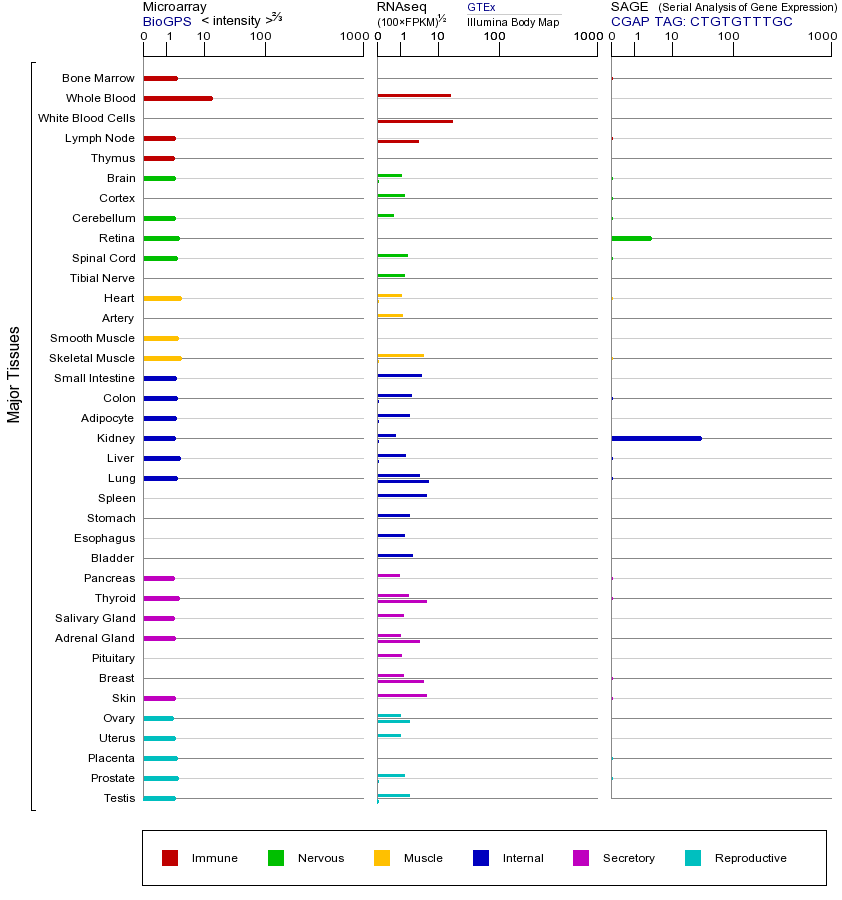CCR3 (C-C motif chemokine receptor 3)
- symbol:
- CCR3
- locus group:
- protein-coding gene
- location:
- 3p21.31
- gene_family:
- Chemokine receptors|CD molecules
- alias symbol:
- CC-CKR-3|CKR3|CD193
- alias name:
- None
- entrez id:
- 1232
- ensembl gene id:
- ENSG00000183625
- ucsc gene id:
- uc003cpg.3
- refseq accession:
- NM_001164680
- hgnc_id:
- HGNC:1604
- approved reserved:
- 1995-05-30
CCR3(C-C趋化因子受体3,C-C chemokine receptor 3)是一种G蛋白偶联受体(GPCR),属于趋化因子受体家族。它主要表达于嗜酸性粒细胞、嗜碱性粒细胞、Th2型辅助T细胞和部分神经元细胞等。CCR3的配体包括多种趋化因子,如CCL5(RANTES)、CCL7(MCP-3)、CCL11(eotaxin-1)、CCL24(eotaxin-2)和CCL26(eotaxin-3)。这些配体通过与CCR3结合,激活下游信号通路(如MAPK和PI3K),介导细胞的迁移、活化和炎症反应。CCR3在过敏性疾病(如哮喘、过敏性鼻炎和特应性皮炎)中发挥关键作用,因为它能招募嗜酸性粒细胞到炎症部位,促进炎症反应。CCR3的突变可能导致受体功能异常,影响免疫细胞的迁移和活化,从而增加过敏性疾病或自身免疫性疾病的易感性。CCR3过表达会增强嗜酸性粒细胞的募集和活化,加剧炎症反应;而降低表达则可能减轻过敏症状。CCR3属于CC趋化因子受体家族(CCR family),该家族成员均能识别CC类趋化因子(即两个半胱氨酸残基相邻的趋化因子),并在免疫细胞迁移和炎症反应中发挥作用。目前针对CCR3的药物(如拮抗剂)正在研发中,用于治疗过敏性疾病和某些炎症性疾病。
The protein encoded by this gene is a receptor for C-C type chemokines. It belongs to family 1 of the G protein-coupled receptors. This receptor binds and responds to a variety of chemokines, including eotaxin (CCL11), eotaxin-3 (CCL26), MCP-3 (CCL7), MCP-4 (CCL13), and RANTES (CCL5). It is highly expressed in eosinophils and basophils, and is also detected in TH1 and TH2 cells, as well as in airway epithelial cells. This receptor may contribute to the accumulation and activation of eosinophils and other inflammatory cells in the allergic airway. It is also known to be an entry co-receptor for HIV-1. This gene and seven other chemokine receptor genes form a chemokine receptor gene cluster on the chromosomal region 3p21. Alternatively spliced transcript variants have been described. [provided by RefSeq, Sep 2009]
由该基因编码的蛋白质为C-C型趋化因子的受体。它属于G蛋白偶联受体家族1。该受体结合并响应各种趋化因子,包括趋化因子(CCL11),趋化因子-3(CCL26),MCP-3(CCL7),MCP-4(CCL13)和RANTES(CCL5)。它是在嗜酸性粒细胞和嗜碱性粒细胞中高度表达,并且在TH1和TH2细胞也检测,以及在气道上皮细胞。该受体可能有助于在过敏性气道的积累和嗜酸性粒细胞和其它炎性细胞的活化。它也被称为是一个条目共受体为HIV-1。该基因等七个趋化因子受体基因形成的染色体区域3p21趋化因子受体基因簇。可变剪接转录物变体已有描述。 [由RefSeq的,2009年09月提供]
基因本体信息
CCR3基因(以及对应的蛋白质)的细胞分布位置:
- 质膜
- 细胞质
- 细胞外
- 高尔基体
- 囊泡
- 细胞骨架
- 内质网
- 细胞核
- 内体
- 溶酶体
- 线粒体
CCR3基因的本体(GO)信息:
| 名称 |
|---|
| 4060 Cytokine-cytokine receptor interaction [PATH:hsa04060] |
| 4062 Chemokine signaling pathway [PATH:hsa04062] |
| 5203 Viral carcinogenesis [PATH:hsa05203] |
| 名称 |
|---|
| Chemokine receptors bind chemokines |
| Class A/1 (Rhodopsin-like receptors) |
| G alpha (i) signalling events |
| GPCR downstream signaling |
| GPCR ligand binding |
| Peptide ligand-binding receptors |
| Signal Transduction |
| Signaling by GPCR |
| 疾病名称 | 关系值 | NofPmids | NofSnps | 来源 |
| HIV Infections | 0.129424521 | 28 | 0 | BeFree_CTD_human_GAD |
| Dermatitis, Atopic | 0.120814326 | 4 | 0 | BeFree_CTD_human |
| Obesity | 0.120542884 | 2 | 1 | BeFree_GWASCAT |
| Status Epilepticus | 0.12 | 1 | 0 | CTD_human |
| Pulmonary Fibrosis | 0.12 | 1 | 0 | CTD_human |
| Respiratory Hypersensitivity | 0.12 | 1 | 0 | CTD_human |
| Asthma, Aspirin-Induced | 0.12 | 1 | 0 | CTD_human |
| Asthma | 0.10654656 | 24 | 0 | BeFree_GAD_LHGDN_RGD |
| Rhinitis | 0.082367032 | 2 | 0 | GAD_RGD |
| Myocardial Infarction | 0.08 | 1 | 0 | RGD |
联系方式
山东省济南市章丘区文博路2号 齐鲁师范学院 genelibs生信实验室
山东省济南市高新区舜华路750号大学科技园北区F座4单元2楼
电话: 0531-88819269
E-mail: product@genelibs.com
微信公众号
关注微信订阅号,实时查看信息,关注医学生物学动态。







